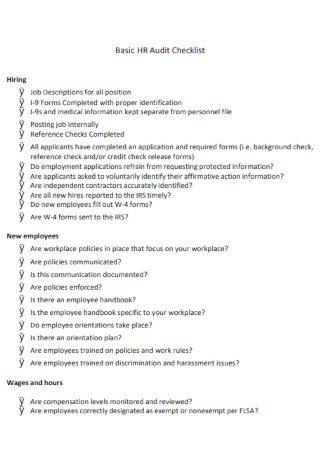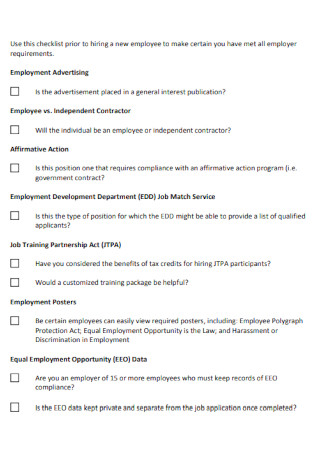11+ SAMPLE Hr Audit Checklist
-

Basic HR Audit Checklist
download now -

HR Audit Checklist Template
download now -

HR Function Audit Checklist
download now -

HR Management Audit Checklist
download now -

Sample HR Audit Checklist
download now -

HR Compliance Audit Checklist
download now -

HR Audit Checklist Example
download now -

Simple HR Audit Checklist
download now -

HR-Audit-Checklist in-PDF
download now -

HR Hire Audit Checklist
download now -

HR Audit Checklist in DOC
download now -

HR Processes Self Audit Checklist
download now
FREE HR Audit Checklist s to Download
11+ SAMPLE Hr Audit Checklist
an HR Audit?
Benefits of an HR Audit Checklist
Methods of HR Audit
How To Be Prepared For an HR Audit
FAQs
What is the human resources audit process?
What is a PDF human resources audit?
Why is an audit of human resources necessary?
What use do certificates serve?
What Is an HR Audit?
A human resources (HR) audit examines your human resource policies, processes, documentation, systems, and practices. The objective of an HR audit is to ascertain the strengths and weaknesses of your current human resource system and make recommendations for areas that could be improved. Not only will you discover whether processes and policies benefit or hinder your entire organization, but you’ll also understand whether you’re at risk of a lawsuit or criminal prosecution. While your human resources audit checklist can be customized to meet the unique demands of your firm, essential items are required for all organizations. According to statistics, only half of businesses (52%) use human resource audits as an early warning system to identify problems before they become crises. In comparison, 80% of surveyed businesses stated that the primary purpose of human resource audits is “to examine the organization’s compliance with established regulations and company policies.”
Benefits of an HR Audit Checklist
Checklists are quality assurance professionals’ auditing tools in inspections and audits. Audit experts are responsible for verifying and ensuring that various accounting standards are followed and adhering to their auditing standards. However, the widespread use of checklists in many audit tasks calls into doubt the auditor’s judgment. Alternative processes must be used in addition to audit checklists. The usage of audit checklists organizes confirming conformity with a specific standard. Also, the way it operates may occasionally result in the omission of various components of inspections and audits. Additionally, here are a few of its additional advantages:
Methods of HR Audit
Human resource auditing is a technique for determining the state of a human resource development system. The following methods are used:
1. Interview Method
The HRD auditor interviews top management and senior management (line managers and employees). It is a structured interview aimed to elicit respondents’ perspectives on the organization’s future growth plans and goals, culture, working style, career development, workflow system, leadership style, morale, motivation, vision and mission, among other things. Due to time and resource restrictions, the HRD auditor interviews employees using sample methodologies.
2. Questionnaire Method
The human resource development auditor creates and administers standardized questionnaires to assess the many characteristics of human resource development. It is customary to conduct a pilot study to determine the instrument’s reliability and validity using proper statistical techniques. Then he must choose the appropriate sample size. The questionnaire should include questions that pertain to the HRD audit’s objectives. It is distributed to sample responders who are required to enter relevant responses.
3. Observation Method
To analyze the suitability and conduciveness of the environment for human resource development, the HRD manager watches employees in their natural habitats, such as the workplace, canteen, training camps, and residential colonies.
4. Desk Research Method
The human resource development manager collects and utilizes information regarding performance appraisal reports, ethical practices, achievement records, welfare measures, career development, the frequency of training programs, participant trainee feedback, methods used to ascertain training needs, safety practices, accident prevention, incentive and compensation systems, and so forth. He analyzes the facts and numbers about the domains above and makes pertinent conclusions. This method does not require respondents to complete a questionnaire or adhere to an interview schedule. The complete data set is derived from the organization’s pertinent records.
5. Workshop Method
Employees are selected for participation in a workshop conducted expressly for the goal of HRD auditing, either by a sampling technique or through some other criterion. All participants who have been chosen are separated into groups. For SWOT analysis, distinct dimensions of human resource development are assigned to different groups. Each group is supposed to create a report and deliver a presentation on the allocated subjects. The outcomes of each group’s message are thoroughly discussed, and recommendations are presented to the organization. The HRD auditor moderates the entire exercise.
6. Task Force Method
A task force comprised of diverse experts from various domains within the organization is formed to identify, assess, and solve the identified HRD issues. The human resource development manager can then focus on the accepted recommendations for ongoing development.
How To Be Prepared For an HR Audit
Human resource audits can be a particularly unpleasant process. Also, it isn’t easy to know how to prepare for an HR audit if you’re still utilizing a paper filing system. Going paperless with your personnel files is the first step toward a more efficient human resources department and better audit preparation. Employee file management software can assist your human resources department keep track of files and ensuring that all folders are complete and current. Here’s how to prepare for a human resources audit.
-
Step 1 Convert Employee Files to Electronic Format
Going paperless with your personnel files is the first step toward excellent HR audit preparation. It is practically hard to maintain an accurate record of personnel documentation on paper. With an electronic system, you gain enhanced security, immediate access, and a significantly higher level of organization. When comparing various solutions, look for products that simplify the transition to electronic employee files. Automated scanning features expedite the transfer of paper employee files to electronic format, allowing your department to become paperless quickly.
-
Step 2 Maintain Track of Required Documents
When an HR auditor visits your office and asks for the files of a dozen random employees, you must ensure that their folders have the necessary documentation. Keeping track of documents using a paper filing system can be a tremendous headache. Staff must physically peruse each employee folder to ensure it is complete. With an electronic system, everything is a lot simpler. A Brief Report can identify which employee folders are lacking needed documents. You can retrieve these reports using your employee file management software, or you can have them emailed to you weekly or monthly automatically. In this manner, if any employee folders lack papers, you’ll always know what’s missing. According to research, requirement traceability assists the development team in two critical ways: It gives context for the development team. Additionally, it describes the testing team’s responsibilities in helping with implementation and specification. Assists the team in developing the right product and the right product.
-
Step 3 Keep Current Certifications
Employees expected to undergo periodic training or are professionally certified add another layer of complexity to human resources audits. Maintaining current records for all employees can be a significant difficulty in a paper-based system. A paperless method may be beneficial. HR can run reports to determine which employees’ certificates are due for renewal by including an expiration date on time-sensitive papers. Again, you may obtain these reports via your employee file management software or have them emailed to you weekly or monthly. This way, you can still be sure that your team is contacted in plenty of time to renew their documents. Also, numerous organizations value and frequently need the credentials of their employees. Certification demonstrates that you have met a minimum level of competence and can provide you with a competitive edge, increased work prospects, a higher pay range, and job stability.
-
Step 4 Keep Auditors Away From Your Business
Having a human resources auditor visit your business can be highly disruptive. It puts employees on edge and can result in a significant drop in productivity. The good news is that when employee files are digitally saved, auditors are no longer required to visit your facility. With electronic employee files, it’s simple to provide your auditor with only the files they request. It makes no distinction whether the files are specified types for all employees or a random list of employee folders. Your employee file management software should make it simple to transmit that information with your auditor via digital means securely.
FAQs
What is the human resources audit process?
An HR audit is a process that involves the examination of a company’s policies, internal procedures, paperwork, and human resource systems—alternatively referred to as conducting a systematic review of all parts of the business. This form of audit is beneficial for finding critical areas for improvement inside the organization.
What is a PDF human resources audit?
A human resources audit thoroughly examines current human resource policies, procedures, documentation, and systems to identify areas for improvement and enhancement and determine compliance with constantly changing rules and regulations.
Why is an audit of human resources necessary?
A human resources audit is critical for organizations that cannot afford to lose money in the event of a lawsuit. Human resource audits assist businesses in determining whether their human resource policies, methods, and practices are lawful and successful. They guarantee that a company complies with all applicable federal, state, and municipal labor regulations.
What use do certificates serve?
The significance of certifications begins with the first phases of the academic path. Upon completing your elementary, high school, college, or university education, you receive certificates. Additionally, credentials assist you in locating positions with firms for whom you wish to work or show your expertise.
Conducting an HR Audit and developing an appropriate action plan from it is just as critical as having one in the first place. Inadequate audits can produce erroneous results, resulting in poor management decisions. As a result, you must have a firm grasp of these audits. The information above should provide you with a good understanding of what, why, and how a human resource audit checklist works.
